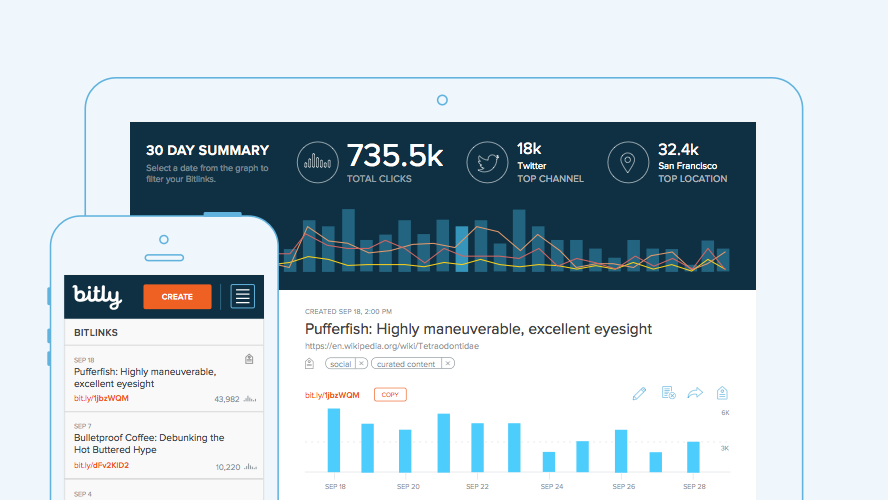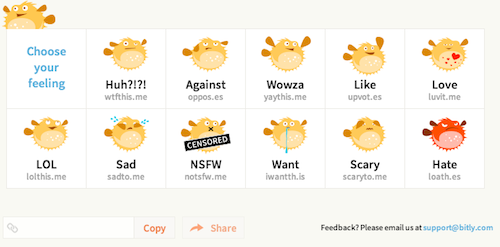Remember what life was like before Twitter? Before you could live-stream events via attendees who wrote near-instantaneous play-by-plays in 140 characters or less? Or before digital flash mobs burned quasi-questionable citizens at the proverbial stake for making a half-baked joke? Me neither. Slash who would want to?
When the social channel first launched, some critics never thought it would last, let alone become as popular as it has. Many even thought Twitter’s 140 character limit was preposterous. “How could anyone consume news in such short snippets?” questioned the journalists. Yet we’ve managed. More than that, it has given rise to a new style of writing – one that feeds short attention spans with quick, creative quips.
It also gave rise, out of necessity, to the popularity of shortened links. Because in some cases links alone took up the entire content capacity of a tweet, and that just wouldn’t suffice. As newly forged creators – and not just consumers – of content, we needed room to give our opinions alongside our URLs. (Even if you didn’t ask for them.)

Though patents for link shortening predate Twitter by at least six years, Tiny URL was actually the first of its kind to launch in 2002. It became widely known as Twitter’s automatic shortening service until 2009, when Bitly took the reigns just one year after its own launch. These days, Bitly claims to be responsible for the shortening of nearly 500 million links per month and the processing of more than eight billion clicks across the same network of links.

Why is it called Bitly?
Headquartered in New York City, and with approximately 70 employees across offices in NY, San Francisco and Denver, Bitly was established as an innovative byproduct of Betaworks in 2008. Like Tiny URL, its primary function is to shorten links. We could postulate that the name itself is as straightforward as that; to make lengthy links just a little BIT smaller. It turns long links into Bit Links, which is exactly what Bitly calls any URL you’ve shortened, and thus, it bitlys your bitlinks. Erica Moss, Community Manager at Bitly, agreed that though the origin of Bitly’s etymology was largely unknown, it was likely related to the definition of bit as a “tiny amount of data.”
Moss also detailed all that Bitly offers beyond link shortening. “Everyone knows Bitly as a link shortener, they get that part. What a lot of people don’t understand is the enterprise functionality behind the curtain – our link management platform. The coolest thing it offers is tracking across channels so you can see who’s clicking, where they’re clicking from, where most referrals come from.”

She describes the enterprise product is the free product on steroids, most notably gaining access to an analytics platform. One of its major tenets is link customization. For brands that buy in (think ESPN or NYT), the enterprise product allows for links to be branded as es.pn or ny.ti so that audiences know immediately what they’re clicking on. Bitly reports more than a 30% increase on click-thru rates for brands who customize over those who don’t.
Because, at one time or another, shortened links were a cause of concern for spam or phishing, Bitly takes abuse very seriously. As a best practice, they recommend, even if you don’t customize the full link via the paid platform, that you still customize what they call “the back half” (i.e., http://bit.ly/rewind) to give readers a sense safety and recognition.
Another feature they boast is what’s known as The Bitly Network, wherein, a brand like ESPN will also get a look at organic shortening of their links in addition to basic analytics. Meaning when anyone, ESPN affiliated or otherwise, shortens an ESPN link via Bitly on their own, Bitly will automatically customize that link and enable ESPN to track that data as well. “You see how you’re sharing content and what happens when other people share it,” Moss said.
Last but not least, Bitly is rolling out a feature called deep-linking, which enables applications to send people very specific pages regardless of the application they use. Say, for example, you get an email from LinkedIn and you click the call-to-action, but then you’re redirected to log in, and once you do, you wind up at the home page rather than the landing page they intended. With deep-linking, Bitly is attempting to correct course, so that brands can send people exactly where they want them to go.

SEE ALSO: Why is Buffer Called Buffer?
As if that weren’t enough, Bitly accompanies it all with a colorfully cheerful mascot by the name of Chauncey McPufferson. Chauncey, a pufferfish who has been with Bitly since its founding, is meant to mirror the uniqueness of the links submitted to Bitly, implying that no two are the same. He has taken many shapes in his role, and at minimum boosts morale when things look grim.
Like, for example, if Bitly were to be at risk of abruptly losing their domain name. That was precisely the case in 2010, when the Libyan government stood to take control of sites ending in .ly. At the time, TechCrunch reported that vb.ly was “seized by NIC.ly (the domain registry and controlling body for the Libyan domain space) because the content of his website, at least in their opinion, was in violation of Libyan Islamic/Sharia Law.” Unless Chauncey’s potential poision frightened them from taking action, it’s likely why Bit.ly now redirects to Bitly.com.
Though with Twitter’s increasing character limit looming, it’s possible that Chauncey will start swimming in a new direction altogether. Thanks for reading Why is Bitly called Bitly! Do you shorten links for social posts? Why or why not? #whyisitcalledBitly
Need some help thinking of your own next big naming idea? Try using a powerful business name generator to springboard your creativity!
Annelise Schoups is a contributor at Rewind & Capture. With a degree in journalism, experience in public relations, and an education in travel, she is passionate about cultivating knowledge and storytelling.






[…] Image Credit: Rewind & Capture […]